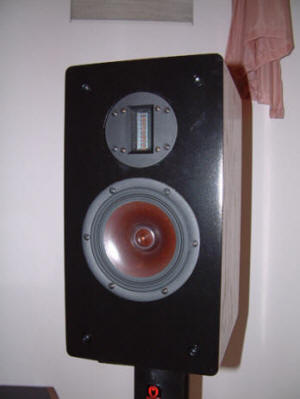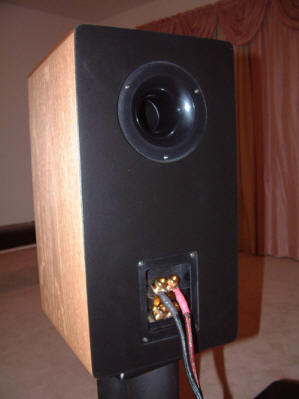You are reading the older HTML site
Positive Feedback ISSUE
15
september/october 2004
selah audio
SA-1 loudspeaker
as reviewed by Fown-Ming Tien

FOWN-MING TIEN'S SYSTEM:
LOUDSPEAKERS
ELECTRONICS
SOURCES
CABLES
ACCESSORIES
|
I have an appreciation for well designed two-way monitor loudspeakers, having owned and auditioned Dynaudio Audience 50s and Contour 1.3 MkIIs, Revel M20s, B&W Signature 805s, Onix Reference 1s, ACI Sapphires, Spendor S3/5s, and many more. While such monitors are simple in design—a tweeter and a mid/woofer controlled by a two-way crossover—the music that flows from them is pure and unadulterated. Good monitors are capable of providing imaging that few (if any) floorstanders can achieve, and they do so in an intimate manner. Of course, two-way monitors will not deliver bonecrushing bass or knock-you-on-the-seat-of-your-pants slam, but due to their simple crossovers, they present music in a wonderfully coherent and engaging manner, with nary any peakiness or disjointedness. The feeling is similar to that of running your fingers along a length of smooth silk. No roughness distracts your attention from what is important—the fabric being woven by the flowing notes. I am pleased to say that I have discovered another silky two-way monitor to add to my list.
The Selah Audio SA-1, designed by Rick Craig, is a two-way speaker that consists of a Fountek ribbon tweeter and a 7-inch Vifa XT18W09 mid/woofer. My first impression was that the cabinet and grille were identical to the ones used in the Van Alstine Biro L/1s, except for the port location—the SA-1 is rear-ported while the Biro is front-ported. In a phone call, Rick Craig confirmed that this was indeed the case, as my review pair of SA-1s had been made from a standard kit available from Madisound. The cabinets come in natural, cherry-stained, or unfinished oak, but if these finishes don't work for you, Rick offers custom finishes for a nominal fee. If you are a handy DIYer, the SA-1 is available in kit form for a mere $460 per pair, plus $90 if you want the deluxe crossover, in which the capacitors in the tweeter section are replaced with Hovland film/foil caps and the series inductor in the woofer section is replaced with a Goertz copper-foil unit. Rick says that these parts provide greater clarity and other positive attributes. Assembled, the SA-1s with the standard crossovers are $850, while the ones with the deluxe crossovers fetch $950.
With a rated frequency response of 44Hz-20kHz (+2/-3dB) and a sensitivity rating of 86dB, these speakers are meant to be used in smaller rooms. The rear ports are rather large in diameter, which allows the speakers to play low bass tones without any audible chuffing at high volume. Speaker connection is handled by high quality, gold-plated binding posts. At this price, I expected binding posts with cheap plastic nuts.
The Fountek ribbon tweeter looks very similar to the Aurum Cantus G2 tweeter that I have heard in Aurum Cantus' own Leisure 2Ds and the GR Research Criterions, both of which I found to be too polite. Would Rick Craig's speakers also sound too polite? And would the dispersion characteristics of the ribbon create the super-narrow sweet spot that the other two speakers also exhibited? I placed the SA-1s on my Osiris 23.5-inch stands, which were positioned two feet from the back wall and a little over two feet from the side walls, and aimed the tweeters at my listening position. Within the first few minutes, I discovered that the SA-1s sounded nothing like the similar speakers I had heard in the past. In short, the SA-1s really BOOGIED! In my room, these speakers were more detailed, dynamic, musical, and engaging than any $850 speakers had a right to be! They sounded stunning!
According to Rick, the Fountek tweeters measure nearly identically to those of the Aurum Cantus G2s, and are far more detailed than the Vifa XT ring radiators or any other silk dome tweeters. I had never found this to be true until I heard the SA-1s. In Rick's speakers, the Fountek ribbons indeed sounded more detailed than the Vifa XTs in my Onix Reference 1s. Details are not harsh or edgy, but smooth and extended. Cymbals have plenty of air and shimmer, but do not sound bright, harsh, or exaggerated. Gil Shaham's violin in The Four Seasons with the Orpheus Chamber Orchestra was pure sweetness, with no hint of brightness. I had heard some of this in the Aurum Cantus L2Ds, but the L2Ds sounded recessed. The SA-1's crossover draws the perfect balance for this tweeter—it is neither too recessed nor too forward. Smooth is the operative word. On Alison Krauss' live album, her voice sounded extended, sweet, and smooth. Every pluck of a guitar string could be clearly heard. I had a difficult time believing that the highs from the SA-1s could be better than the ones provided by my Onix Reference 1s. I have compared my speakers to monitors costing more than $3000, and never heard ones that produced better highs. To encounter $850 speakers that did so was a shock. After going back and forth numerous times between my speakers and the SA-1s, I was able to confirm that the SA-1s' highs were not only more detailed, but more refined.
The SA-1s' midrange was extremely engaging, with a very warm, relaxed, and natural feel. Natalie Cole's voice on "Unforgettable" was absolutely mesmerizing. Josh Groban's voice has never been smoother, although it lacked a bit of detail when compared to my reference speakers. I believe this is due to Rick Craig's choice of woofer. The Vifa XT18W09 serves as a wonderful midrange and midbass driver, although its 7-inch size does seem to compromise a bit of midrange speed and detail compared to the 5.25-inch drivers in my monitors. The SA-1s' midrange is very good, but I have yet to hear monitors that have the speed and snap in the midrange and midbass regions as mine. Of course, my speakers cost $650 more than the SA-1s.
The SA-1s' bass is on the warm side, a bit warmer than I prefer, but they extend nicely for monitors, to 29Hz at –10dB. On Norah Jones' "Feeling the Same Way," the bass was a bit too warm and fuzzy. Rick says that the cabinets that come with his custom finishes are more rigid, which tightens up the bass. This is just nitpicking on my part, since I have never heard any monitors under $1000 per pair that deliver bass of this quality. In fact, of all the monitors I've heard, the only two that deliver tight, dry bass in satisfying quantity are the Spendor S3/5s and Onix Reference 1s.
The SA-1s do an amazing job of getting out of the way. I never got the sense that the music was emanating from two point sources. Their tweeters allow them to image extraordinarily well. The soundstage is deep and wide. The other two ribbon monitors I've heard had extremely narrow horizontal dispersion characteristics—moving my head just three inches to either side caused the soundstage to collapse. As should be expected with ribbon tweeters, vertical dispersion is limited, meaning that when you move your head above or below the level of the tweeters, high frequency detail suffers a little.

I had to constantly remind myself that I was listening to an $850 pair of speakers, as their treble is better than any monitors I have ever heard, and their midrange is better than most monitors costing up to $2500. I invited a couple of friends over to hear them, and their opinions were pretty much in line with mine. When I told them how much the SA-1s cost, they fell over in disbelief. In the highly competitive monitor market, the Selah Audio SA-1s are true diamonds in the rough. For their ability to deliver smooth, balanced, warm, and engaging music for less that $1000, Rick Craig's SA-1s would be an easy choice if I were in the market for inexpensive monitors. They do so many things right, and nothing wrong! These are must-hear speakers, and I will miss them tremendously when I have to pass them on. If I did not already own Reference 1s, these speakers would not be going anywhere. They do make me wonder: If Rick's entry-level speakers can deliver this much at a bargain price, what could his higher-priced offerings do? Fown-Ming Tien
Selah Audio
web address: www.selahaudio.com
